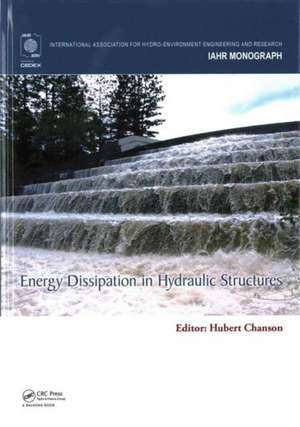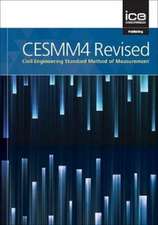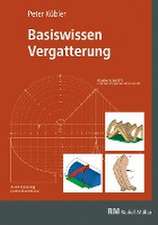Energy Dissipation in Hydraulic Structures: IAHR Monographs
Editat de Hubert Chansonen Limba Engleză Hardback – 12 mai 2015
The magnitude of turbulent energy that must be dissipated in hydraulic structures is enormous even in small rural and urban structures. For a small storm waterway discharging at a 4 m3/s mm high drop, the turbulent kinetic energy flux per unit time is 120 kW! At a large dam, the rate of energy dissipation can exceed tens to hundreds of gigawatts; that is, many times the energy production rate of nuclear power plants. Many engineers have never been exposed to the complexity of energy dissipator designs, to the physical processes taking place and to the structural challenges. Several energy dissipators, spillways and storm waterways failed because of poor engineering design. It is believed that a major issue affecting these failures was the lack of understanding of the basic turbulent dissipation processes and of the interactions between free-surface aeration and flow turbulence.
In that context, an authoritative reference book on energy dissipation in hydraulic structures is proposed here. The book contents encompass a range of design techniques including block ramps, stepped spillways, hydraulic jump stilling basins, ski jumps and impact dissipators.
| Toate formatele și edițiile | Preț | Express |
|---|---|---|
| Paperback (1) | 421.79 lei 43-57 zile | |
| CRC Press – 30 iun 2020 | 421.79 lei 43-57 zile | |
| Hardback (1) | 625.59 lei 43-57 zile | |
| CRC Press – 12 mai 2015 | 625.59 lei 43-57 zile |
Din seria IAHR Monographs
- 8%
 Preț: 389.79 lei
Preț: 389.79 lei -
 Preț: 354.19 lei
Preț: 354.19 lei - 25%
 Preț: 1107.98 lei
Preț: 1107.98 lei - 12%
 Preț: 325.34 lei
Preț: 325.34 lei - 12%
 Preț: 338.42 lei
Preț: 338.42 lei - 15%
 Preț: 421.79 lei
Preț: 421.79 lei -
 Preț: 430.43 lei
Preț: 430.43 lei - 11%
 Preț: 320.21 lei
Preț: 320.21 lei - 11%
 Preț: 321.98 lei
Preț: 321.98 lei - 25%
 Preț: 495.45 lei
Preț: 495.45 lei - 12%
 Preț: 325.34 lei
Preț: 325.34 lei - 8%
 Preț: 341.38 lei
Preț: 341.38 lei -
 Preț: 357.34 lei
Preț: 357.34 lei - 18%
 Preț: 902.92 lei
Preț: 902.92 lei - 18%
 Preț: 2206.98 lei
Preț: 2206.98 lei - 25%
 Preț: 1225.71 lei
Preț: 1225.71 lei
Preț: 625.59 lei
Preț vechi: 839.33 lei
-25% Nou
Puncte Express: 938
Preț estimativ în valută:
119.70€ • 125.32$ • 99.05£
119.70€ • 125.32$ • 99.05£
Carte tipărită la comandă
Livrare economică 07-21 aprilie
Preluare comenzi: 021 569.72.76
Specificații
ISBN-13: 9781138027558
ISBN-10: 1138027553
Pagini: 178
Ilustrații: illustrations
Dimensiuni: 174 x 246 x 15 mm
Greutate: 0.48 kg
Ediția:1
Editura: CRC Press
Colecția CRC Press
Seria IAHR Monographs
ISBN-10: 1138027553
Pagini: 178
Ilustrații: illustrations
Dimensiuni: 174 x 246 x 15 mm
Greutate: 0.48 kg
Ediția:1
Editura: CRC Press
Colecția CRC Press
Seria IAHR Monographs
Public țintă
ProfessionalCuprins
1. Introduction: Energy dissipators in hydraulic structures 2. Energy dissipation at block ramps 3. Stepped spillways and cascades 4. Hydraulic jumps and stilling basins 5. Ski jumps, jets and plunge pools 6. Impact dissipators 7. Energy dissipation: Concluding remarks
Recenzii
"Many open channel and pipe flows are highly energetic – notable examples include flood overflows down the spillways of large dams. The IAHR monograph, Energy Dissipation in Hydraulic Structures, edited by Hubert Chanson, provides a contemporary account of modern developments in assessing and designing hydraulic structures aimed at lowering the energy levels of high-energy free surface flows. The book considers energy dissipation by a wide range of hydraulic structures including chutes, spillways and stilling basins. It is written by some of the leading experts in the field and is crammed full of useful information. [...]
In the reviewer’s opinion, Energy Dissipation in Hydraulic Structures, edited by Hubert Chanson, is recommended reading for hydraulic engineers engaged in the design and maintenance of energy-dissipation devices. With some further polishing, this book could become the gold standard in the subject. This reviewer is left viewing hydraulic structures in a new, more awe-inspired light."
Book review by Alistair G.L. Borthwick in 'Engineering and Computational Mechanics' Vol. 170 (March 2017).
In the reviewer’s opinion, Energy Dissipation in Hydraulic Structures, edited by Hubert Chanson, is recommended reading for hydraulic engineers engaged in the design and maintenance of energy-dissipation devices. With some further polishing, this book could become the gold standard in the subject. This reviewer is left viewing hydraulic structures in a new, more awe-inspired light."
Book review by Alistair G.L. Borthwick in 'Engineering and Computational Mechanics' Vol. 170 (March 2017).
Descriere
In hydraulic engineering numerous devices like stilling basins, baffled aprons, and vortex shafts are known under the collective term of energy dissipators. Their purpose is to dissipate hydraulic energy, i.e. to convert this energy mainly into heat. Dissipators are used in places where the excess hydraulic energy could cause damage such as erosion of tailwater channels, abrasion of hydraulic structures, generation of tailwater waves or scouring. Energy dissipators are an important element of hydraulic structures as transition between the highly explosive high velocity flow and the sensitive tailwater.
This volume examines energy dissipators mainly in connection with dam structures and provides a review of design methods. It includes topics such as hydraulic jump, stilling basins, ski jumps and plunge pools. It also introduces a general account of various methods of dissipation, as well as the governing flow mechanisms.
The book will be of interest to Civil and Environmental Engineers, Hydraulic and Mechanical Engineers working in academic and professional environments.
This volume examines energy dissipators mainly in connection with dam structures and provides a review of design methods. It includes topics such as hydraulic jump, stilling basins, ski jumps and plunge pools. It also introduces a general account of various methods of dissipation, as well as the governing flow mechanisms.
The book will be of interest to Civil and Environmental Engineers, Hydraulic and Mechanical Engineers working in academic and professional environments.
Notă biografică
Hubert CHANSON received a degree of 'Ingénieur Hydraulicien' from the Ecole Nationale Supérieure d'Hydraulique et de Mécanique de Grenoble (France) in 1983 and a degree of 'Ingénieur Génie Atomique' from the 'Institut National des Sciences et Techniques Nucléaires' in 1984. He worked for the industry in France as a R&D engineer at the Atomic Energy Commission from 1984 to 1986, and as a computer professional in fluid mechanics for Thomson-CSF between 1989 and 1990. From 1986 to 1988, he studied at the University of Canterbury (New Zealand) as part of a Ph.D. project.
Hubert CHANSON is Professor in Hydraulic Engineering and Applied Fluid Mechanics at the University of Queensland since 1990. His research interests include design of hydraulic structures, experimental investigations of two-phase flows, coastal hydrodynamics, water quality modelling, environmental management and natural resources. In 1999 he was awarded a Doctor of Engineering from the University of Queensland for outstanding research achievements in gas-liquid bubbly flows.
Hubert CHANSON has been active also as consultant for both governmental agencies and private organisations. He is the main author of six books.
Awards received:
- The 13th Arthur Ippen award for outstanding achievements in hydraulic engineering (International Association of Hydraulic Engineering & Research)
- 2004 award for the best practice paper in the Journal of Irrigation and Drainage Engineering (ASCE-EWRI)
Hubert CHANSON is Professor in Hydraulic Engineering and Applied Fluid Mechanics at the University of Queensland since 1990. His research interests include design of hydraulic structures, experimental investigations of two-phase flows, coastal hydrodynamics, water quality modelling, environmental management and natural resources. In 1999 he was awarded a Doctor of Engineering from the University of Queensland for outstanding research achievements in gas-liquid bubbly flows.
Hubert CHANSON has been active also as consultant for both governmental agencies and private organisations. He is the main author of six books.
Awards received:
- The 13th Arthur Ippen award for outstanding achievements in hydraulic engineering (International Association of Hydraulic Engineering & Research)
- 2004 award for the best practice paper in the Journal of Irrigation and Drainage Engineering (ASCE-EWRI)













